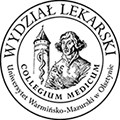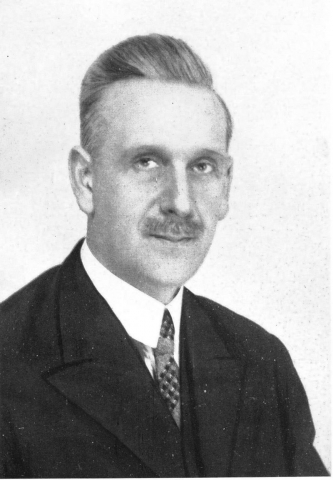Maksymilian Rose
Maksymilian Rose was born on May 19, 1883 in Przemyśl – the town, which at that time was annexed by the Austro Hungarian Empire – into a rather poor Jewish family, as the son of Eliasz Rose and Lea née Israelowicz. Initially he was educated in middle school in his hometown, but then the family moved to Wadowice – a small town near Cracow. Here Rose completed his secondary education and on June 1902 he graduated the secondary school with distinction.
Then Rose started to study medicine at the Jagiellonian University in Cracow. During the studies he actively participated in political life and took part in patriotic manifestations against the Austro-Hungarian government. Prof. Mieczysław Konopacki – the colleague of the above-mentioned Rose: “Rose spoke beautifully and with gusto during student mass meetings. At that time I did not think that he will soon go the way of science”. Contrary to such opinion, Rose during the study started to work from 1907 at the Neurological and Psychiatric Department and Clinic directed by Jan Piltz, and after graduation with distinction in 1908 became an assistant at this department. On September 1, 1908 Maksymilian Rose married Stella Schornstein. It should be underlined that Stella who graduated the Jagiellonian University in 1909 was one of the first five women graduates of this university. Moreover, she helped her husband in later laboratory studies on the nervous system.
In 1910 Rose went for a two-year internship in the best neurological centers in Switzerland and Germany. Initially he studied in Berlin under Herman Oppenheim and Theodor Ziehen – world famous neurologists and psychiatrists. In 1911 Rose moved to Switzerland, where he worked as an assistant at Psychiatric Clinic in Rheinau. Next year Rose came back to Germany and took a job at a clinic in Tubingen directed by prof. Robert Grapp. At that time, Rose also worked at an anatomical and histological laboratory, where he studied the brain cytoarchitecture under prof. Korbinian Brodmann – who became famous for his definition of the cerebral cortex. At that time (in 1912) Rose published the first scientific work, which concerned the cytoarchitecture of the brain cortex in mice, guinea pigs, bats and moles.
In 1913 Rose came back to Cracow. He did not receive an extension of employment at the Neurological and Psychiatric Department, where he worked before the internship. So, he took a job in the Descriptive Anatomy Unit of the Jagiellonian University, directed by prof. Kostanecki – the excellent anatomist, and endearing teacher, hugely popular by students and co-workers. Here Rose started his own scientific studies on the cytoarchitecture of the brain. First of all, he investigated the cytology of neurons in the cerebral cortex in various species. Eufemiusz Herman mentioned that Rose liked the silence of laboratory and anatomical studies more than movement at the hospital.
The scientific studies of Rose were interrupted in 1914 by World War I. During the war Rose served in the Austro-Hungarian army. Initially he was the battalion and regimental doctor, and in the years 1916-1918 was a head of department of neuronal and mental diseases at garrison hospital in Przemyśl and general surgeon of Polish Legions. After Poland regained independence in 1918, Rose served in the Polish army and headed military hospitals in Cracow. Not long after the war he was discharged from the army at the rank of surgeon major, came back to the Descriptive Anatomy Unit and continued works on the cytoarchitecture of the brain.
Scientific successes (especially works about histological principles of divisions of the cerebral cortex) earned Rose international attention and caused him to receive an invitation to Berlin from prof. Oskar Vogt and in 1925 he was appointed the prospective director at the Department of neurology at the Kaiser Wilhelm Institute for Anthropology, Human Heredity and Eugenics. On December of 1925 Rose was licensed for the practice of medicine in Germany and in 1926 he obtained a doctoral degree. In the same year he became a member of the Institute’s Scientific Board and editorial board of “Journal für Psychologie und Neurologie” – a leading neurological scientific journal in Germany. From November 1927 Rose became an editor-in-chief of this journal. In Berlin Rose worked on two atlases of the cerebral cortex cytology and cytoarchitectonics (he described cortex of the mouse and rabbit).
Despite good conditions to scientific work and general recognition, Rose wanted to come back to Poland. In 1928 he went (despite the protest of German professors Oskar Vogt and Walther Spielmeyer) to Warsaw and completed a habilitation thesis on the basis of a dissertation entitled “About cytoarchitecture of the protocerebrum of the turtle”. Simultaneously he set to work on the organization of the Polish Brain Research Institute. All works connected with the institute Rose did without the payment. So he worked as a general practitioner and as a surgeon at the Mental Hospital in Tworki, near Warsaw. The Polish Brain Research Institute was opened in 1930 and Rose was appointed the head of it. It should be pointed out that initially the institute was modestly furnished and located only in two small rooms at the department of Histology and Embryology at Warsaw University. Despite this Rose at that time introduced the Cajal’s method (modern neuropathological staining technique) for studies on the brain.
In 1931 Rose was appointed as the chairman at the Psychiatry Department of the University of Vilnius. Rose moved to Vilnius, transferring the Polish Brain Institute with him. At that time Rose was also appointed the director of the Country Mental Hospital in Vilnius by the Ministry of Social Services. In 1933 he also became the head of the Neurological Clinic, and in 1934 he received the title of full professor.
In Vilnius, Rose organized a new Polish Brain Institute, founded the Agricultural Centre in Kojrany (as the place of treatment of patients with mental diseases), formed The Society for the Protection of Mentally Ill Patients and was the most active member of the Vilnius Medical Association. Simultaneously Rose worked at the Brain Institute and cooperated with scientists from all over the world and tried to publish an international scientific journal. In 1935, after the death of Marshal Józef Piłsudski, a political leader of the Second Polish Republic, Rose (as the most prominent neuroanatomist in Poland) was appointed to study his brain. Unfortunately he did not finish these studies.
The hard work impaired the health of Rose. He died suddenly on November 30, 1937 from a heart attack, during a short break between his lectures on psychiatry, at the age of 54 and at the peak of his scientific career. Rose was buried at the New Jewish Cemetery in Cracow. In a funeral eulogy, prof. Wóycicki, the Rector of the University of Vilnius stated that “the death of Maximilian Rose is a profound loss for the scientific community, we lost a man of a superior intellect and with a good heart”.
Scientific work of Maksymilian Rose
Maksymilian Rose was the author of several dozen scientific articles published in Polish, German and Spanish. Rose took the view that only exact knowledge of anatomy may allow a good understanding of the functions of the nervous system under physiological conditions and during pathological states. So, first of all he studied the anatomy and cytoarchitecture of the brain, as well as embryology of the nervous system. Rose studied the brain anatomy in a wide range of animal species and devised the monumental, richly illustrated atlases of the brain cytoarchitecture in (among others) mice, bats, turtles, rabbits, birds and guinea pigs. For the first time Rose noted that the cerebral cortex consists of six layers only in mammals. Moreover, Rose introduced his own nomenclature to determine the particular parts of the cerebral cortex, for example “cortex semiparietinus” or “cortex totoparietinus”. On the basis of his studies, Rose introduced the original “histogenetic” classification of the cerebral cortex (based on the morphological and phylogenetic criteria), where the following main kinds of the cortex could be distinguished: the primary cortex (semicortex), new cortex (totocortex) and intermediate cortex. Together with Max Bielschowsky, Rose devised a method for selective staining of V and VI layers of the cerebral cortex using indophenol, which was presented in 1927. These studies gained recognition all over Europe and Rose was invited to write two chapters in a neurology manual edited by Oswald Bumke and Otfrid Foerster (the most prominent neurologists of that time), published in 1935.
Rose also tried to attribute the functional roles to the particular areas of the cortex. For example, during studies of the brain of prof. Stanisław Trzebiński (who died in 1930) Rose concluded that a relatively underdeveloped temporal gyrus may suggest that Trzebiński was not interested in music, but perfectly developed frontal lobes may testify to his high intellectual capacity. It should be underlined that before the studies Rose did not know Trzebiński, and the information collected later confirmed the observations collected during the brain examination.
The second aspect of the studies of Rose were correlations between the cytoarchitecture of the brain and neurological and mental disorders. Among others, Rose observed the atrophy of small neurons in the striatum during the torsion dystonia and scattered changes in glial cells during Recklinghausen’s disease. Rose was also a pioneer of studies on the biochemical activity of the brain and correlations between oxidative factors and changes in the brain cortex. Moreover he was a pioneer of Insulin shock therapy during schizophrenia in Poland



